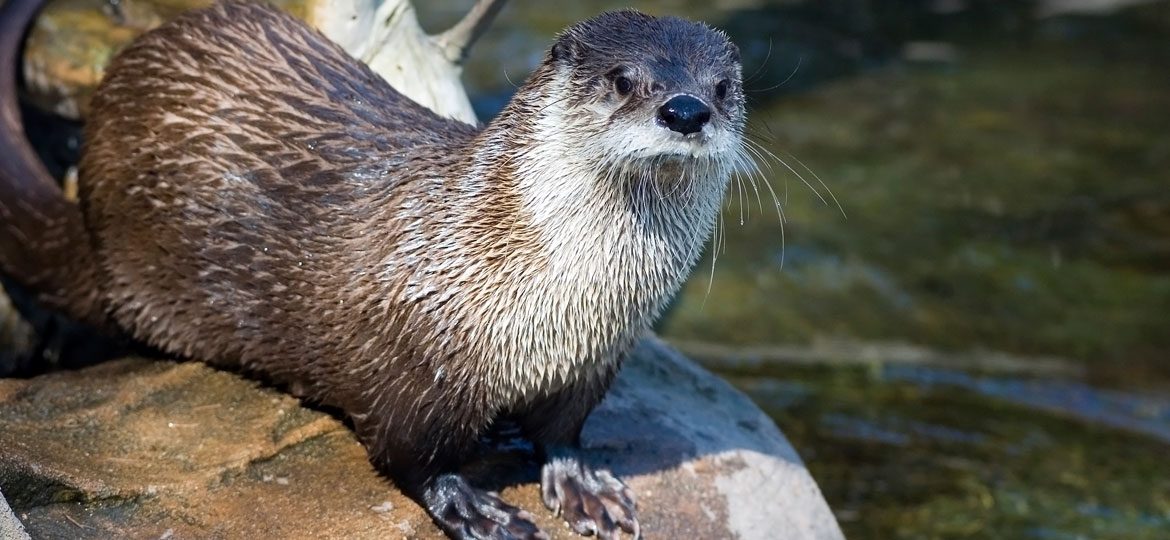Vermont Fish and Wildlife Otter Babies Fish and Wildlife Services

The river otter (Lutra canadensis) is the best swimmer of the weasel, or Mustelidae, family unit. It is at dwelling house in streams, rivers, ponds and lakes and is well-adapted for its aquatic lifestyle.
The river otter is a remarkable animal to spotter on the movement, either in the water or on the shore. Its dense fur coat is prized by trappers. The loss of habitat and over trapping in the 1800s led to a pass up in their numbers in Vermont. However, the river otter has fabricated a comeback since.
Habitat
Suitable habitat for river otters is whatever wetland that provides adjacent bank vegetation, burrow sites, and a nutrient supply. Otters tin can be found in streams, rivers, ponds, and lakes. During the winter, they may get out ponds and lakes that freeze over for the open up water of rivers and streams.
Burrows may be constructed in the depository financial institution or in submerged trees. They will too use the abandoned burrows of other animals including beaver lodges. Factors that are considered in a den site location are food availability, cover, water supply, and man action. Though otters will usually "scent" or mark their territories, they generally practice not fight in defense of this surface area.
River otters tin can exist seen at any fourth dimension of day but are considered to be nocturnal, or most active at night. They are not social. A group may exist comprised of a female and her young. Generally, the males alive separately except during the breeding flavour.
They are very intelligent and evidence a great marvel and playfulness. Excellent swimmers and divers, a common activeness is sliding into the water along riverbanks, seemingly just for pleasure.
Reproduction
In the northeast river otters breed from March to April. Later mating, the fertilized egg remains in limbo through a process known as delayed implantation. During this process, all development of the embryo ceases for approximately ix to ten months. After this fourth dimension, the fertilized egg is implanted into the uterus wall and development of the embryo begins.
Afterwards a seven-week gestation period, the immature are born in tardily March to May of the following yr. The litter size varies from ane to five, with two or three being average. The young are born altricial, (sightless and nearly helpless) and are raised in a leaf or grass lined den of a hollow log or abandoned den near water.
They spend the starting time couple months of their lives slowly developing and growing. The kits open their eyes afterward about twenty days. They are more often than not weaned from their female parent's milk at ten to 14 weeks. And by three to four months, they are able to leave the den.
The female person otter is responsible for raising the young, teaching them how to swim and chase, with the male assisting one time they are older. At six months of age, the young are mature and independent of their parents. They will accomplish sexual maturity at the historic period of two, and females typically take i litter every year.
Nutrition
Regardless of its playful nature, the river otter is however a carnivore that feeds on other animals. Favorite foods include fish, frogs, crayfish, snakes, turtles, amphibians, birds and small mammals.
Unlike another members of the weasel family, the river otter avoids eating feces (dead animals). Their preferred food is fish and they will eat trout, bass, and perch. Nonetheless, the river otter is more than likely to take species that are slower swimmers and easier to catch like suckers and bullhead.
The otter uses its sense of sight as its principal means of hunting. Its long, strong whiskers as well aid it in locating and catching fish in murky water. Depending on h2o depth, the otter will vary its hunting strategy. In shallow water, information technology ordinarily walks along and searches for bottom home species nether rocks. In deeper water, it searches with its head underwater and, in even deeper water, it will submerge its entire torso in search of prey.
Management
The river otter population is monitored closely to regulate hunting and trapping limits. In Vermont, it is protected from over hunting with the flavor only lasting about five months, from the end of October through the finish of March. This fourth dimension of year is chosen to protect against mothers or newborns being harvested. Another management tool is to protect its preferred habitat. In that location are some programs in various parts of the otter'southward range that focus on wetland protection and restoration to maintain current otter populations in these areas.
Status
The river otter has an extensive range roofing much of the United States except for the desert regions of the southwest. Even so, due to loss of habitat, pollution, and excessive harvesting years ago, its numbers have experienced a significant decline.
Source: https://vtfishandwildlife.com/learn-more/vermont-critters/mammals/river-otter
0 Response to "Vermont Fish and Wildlife Otter Babies Fish and Wildlife Services"
Post a Comment